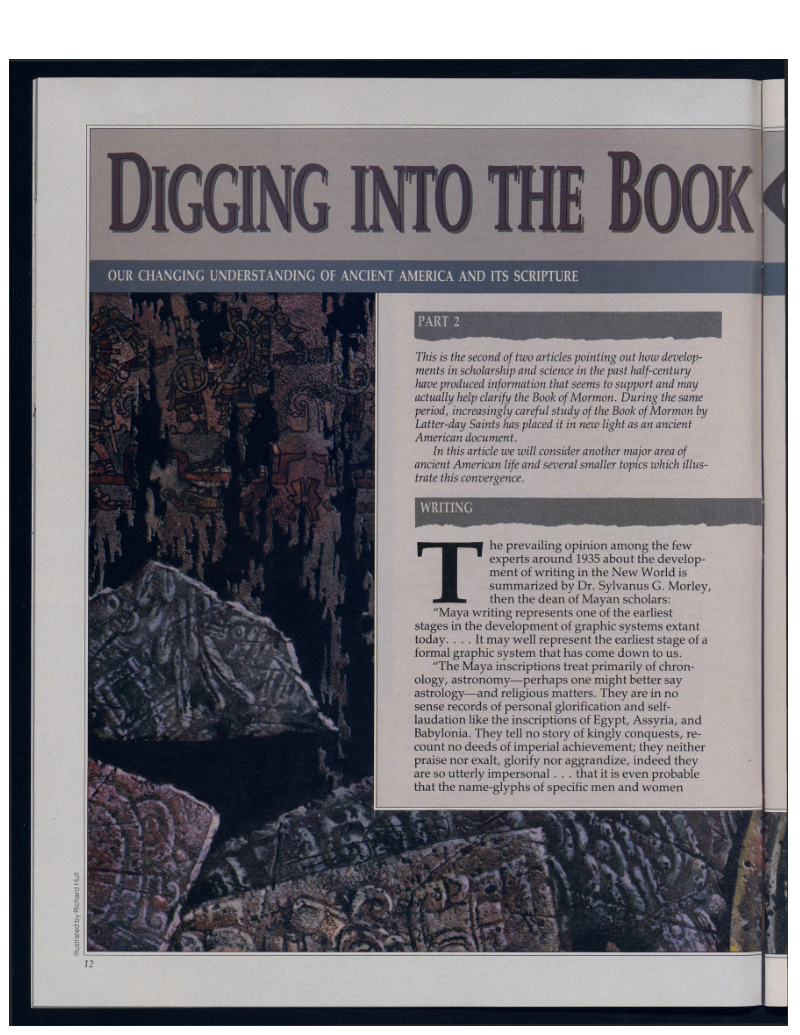Part 2 of Sorenson's series on the limited geography of the BOM for the Ensign.
- Type
- Periodical
- Hearsay
- DirectSecondary
- Reference
John L. Sorenson, "Digging into the Book of Mormon," Ensign, October 1984, 12–23
- Scribe/Publisher
- Ensign
- Audience
- Reading Public
- Transcription
Part 2
This is the second of two articles pointing out how developments in scholarship and science in the past half-century have produced information that seems to support and may actually help clarify the Book of Mormon. During the same period, increasingly careful study of the Book of Mormon by Latter-day Saints has placed it in new light as an ancient American document.
In this article we will consider another major area of ancient American life and several smaller topics which illustrate this convergence.
. . .
Reprise
I have said repeatedly that the correspondences in geography, history, and cultural patterns—large scale or micro-scale—between Mesoamerican cultures and the Book of Mormon peoples do not “prove” anything conclusively. Still, the fact that large numbers of such correspondences exist ought to register in the minds of truth-loving people. With this in mind, it is clearly misleading for a scholar—one of our own—to imply that there is no “important archaeological evidence” to support the Book of Mormon story “of Indian origins,” or for another to find it amusing to think that anyone would seriously try to compare the Book of Mormon with objective facts of historical importance.
Up-to-date, informed people ought not to make such out-dated statements. Nor should archaeologists unprepared in the appropriate materials editorialize off the tops of their heads about the historicity of the Book of Mormon. The demonstrated congruence of Book of Mormon patterns with a vast amount of data on Mesoamerica, even without considering its agreement with Old World patterns, really ought to silence would-be commentators until they have carefully investigated what is now a complex body of information. And those who do investigate and discuss the subject should only do so when they follow sound methodology.
Carefully compared with the facts from external sources, the Book of Mormon is impressive, in my view, though most of the task still remains to be done. Yet the book itself stands above and independent of whatever academic studies of it may show. Neither critics nor apologists change history; they can only provide commentary on a reality more profoundly influential than anything they may say about it.
That the Mesoamerican experts in the first third of this century should have been poorly informed and seriously mistaken about civilization in the area need not surprise us. They did the best they could with the information available to them, but it was limited. Today, too, the best informed scholars are bound to be mistaken, in the long run, on important topics about ancient America. The best defense against this disability is an open mind.
Mesoamerican archaeologists were recently taken to task by one of their number for “a determined and often defiant adherence to assumptions that were no longer tenable. … New discoveries … wreak havoc with old hypotheses. Nonetheless, the hypotheses were presented as theories and defended fiercely, to the detriment of … scientific knowledge of the inhabitants of prehispanic Mesoamerica.” So says Dr. Judith Ann Remington. 54 The archaeologists now at the top of the Establishment heap, she complains, have considered novel explanations—ideas at variance with their own orthodoxy—as “speculations … dangerously close to talking about the mystical properties of pyramids, the advent of alien cosmonauts, or the search for the lost tribes of Israel.” She believes a new generation of Meso-american specialists is coming on the scene less hidebound and less worried that unconventional ideas might “disrupt the entire field of Mesoamerican research,” as one of the famous men put it, and more concerned with simply finding truth. We Latter-day Saints can hope that the new generation will seriously consider the Book of Mormon in relation to current archaeological findings.
Yet we need not feel self-righteous when the scholars are taken to task for their narrowness. Our people have exhibited a decided tendency to substitute comfortable “folk understanding” for facts on certain subjects, particularly having to do with archaeology. We must expect new facts and new interpretations about the ancient Nephites and Jaredites, for they are bound to come. Elder B. H. Roberts taught us wisely about this openness:
“And let me here say a word in relation to new discoveries in our knowledge of the Book of Mormon, and for matter of that in relation to all subjects connected with the work of the Lord in the earth. We need not follow our researches in any spirit of fear and trembling. We desire only to ascertain the truth; nothing but the truth will endure; and the ascertainment of the truth and the proclamation of the truth in any given case, or upon any subject, will do no harm to the work of the Lord which is itself truth. Nor need we be surprised if now and then we find our predecessors, many of whom bear honored names and deserve our respect and gratitude for what they achieved in making clear the truth, as they conceived it to be—we need not be surprised if we sometimes find them mistaken in their conceptions and deductions; just as the generations who succeed us in unfolding in a larger way some of the yet unlearned truths of the Gospel, will find that we have had some misconceptions and made some wrong deductions in our day and time …” All which is submitted, especially to the membership of the Church, that they may be prepared to find and receive new truths both in the Book of Mormon itself and about it.
- Source Link
- https://catalog.churchofjesuschrist.org/assets/1b403213-5d86-478e-9d54-cd8caada5ad7/0/13?lang=eng
- Citations in Mormonr Qnas
The B. H. Roberts Foundation is not owned by, operated by, or affiliated with the Church of Jesus Christ of Latter-day Saints.

